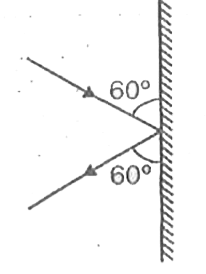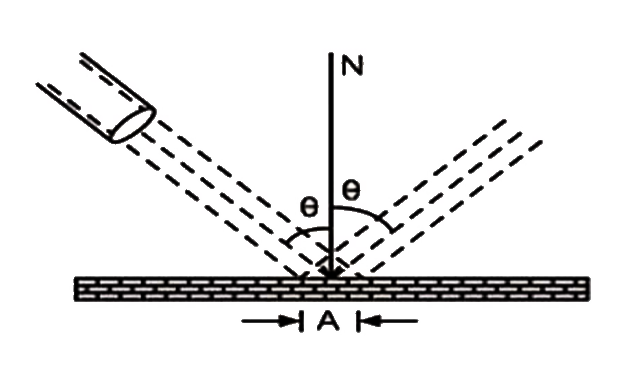Wind with a velocity 100kmh−1 blows normally against one of the walls of a house with an area of 108m2. Calculate the force exerted on the wall if the air moves parallel to the wall after striking it and has a density of 1.2kgm−3.
To solve the problem, we need to calculate the force exerted on the wall by the wind. Here’s a step-by-step breakdown of the solution:
Step 1: Convert Wind Velocity to m/s
The wind velocity is given as 100km/h. We need to convert this to meters per second (m/s).
V=100km/h=100×1000m1km×1h3600s=100000m3600s≈27.78m/s
Step 2: Identify Given Values
We have the following values:
- Area of the wall, A=108m2
- Density of air, ρ=1.2kg/m3
- Wind velocity, V≈27.78m/s
Step 3: Calculate the Force Exerted on the Wall
The force exerted by the wind on the wall can be calculated using the formula:
F=A⋅ρ⋅V2
Substituting the values we have:
F=108m2⋅1.2kg/m3⋅(27.78m/s)2
Calculating V2:
(27.78)2≈771.84m2/s2
Now substituting this back into the force equation:
F=108⋅1.2⋅771.84≈10000.2N
Step 4: Final Result
Rounding off, we find that the force exerted on the wall is approximately:
F≈105N
Summary
The force exerted on the wall by the wind is approximately 105N.
---
The wind velocity is given as 100km/h. We need to convert this to meters per second (m/s).
We have the following values:
- Area of the wall, A=108m2
- Density of air, ρ=1.2kg/m3
- Wind velocity, V≈27.78m/s
The force exerted by the wind on the wall can be calculated using the formula:
Rounding off, we find that the force exerted on the wall is approximately:
The force exerted on the wall by the wind is approximately 105N.
Topper's Solved these Questions
- NEWTON'S LAWS OF MOTION 1Book:CENGAGE PHYSICS ENGLISHChapter:NEWTON'S LAWS OF MOTION 1Exercise:Exercise 6.2
Explore 35 Videos
- NEWTON'S LAWS OF MOTION 1Book:CENGAGE PHYSICS ENGLISHChapter:NEWTON'S LAWS OF MOTION 1Exercise:Exercise 6.3
Explore 19 Videos
- NEWTON'S LAWS OF MOTION 1Book:CENGAGE PHYSICS ENGLISHChapter:NEWTON'S LAWS OF MOTION 1Exercise:Solved Examples
Explore 11 Videos
- MISCELLANEOUS VOLUME 2Book:CENGAGE PHYSICS ENGLISHChapter:MISCELLANEOUS VOLUME 2Exercise:INTEGER_TYPE
Explore 10 Videos
- NEWTON'S LAWS OF MOTION 2Book:CENGAGE PHYSICS ENGLISHChapter:NEWTON'S LAWS OF MOTION 2Exercise:Integer type
Explore 1 Video
Similar Questions
A stream of water flowing horizontally with a speed of 15ms−1 pushes out of a tube of cross sectional area 10−2m2 and hits a vertical wall near by what is the force exerted on the wall by the impact of water assuming.that it does not rebound? (Density of water =1000kgm3)
View SolutionWater from a hosepipe of radius 5 cm strikes a wall at a speed of 5ms−1 normally and stops. The force exerted on the wall in newton is
View Solution
Knowledge Check
A stream of water flowing horizontally with a speed of 15ms−1 pushes out of a tube of cross sectional area 10−2m2 and hits a vertical wall nearby. What is the force exerted on the wall by the impact of water assuming that it does not rebound? (Density of water =1000kgm−3)
A1.25×103NB2.25×103NC3.25×103ND4.25×103N
A body of mass 3 kg moving with velocity 10 m/s hits a wall at an angle of 60∘ and returns at the same angle. The impact time was 0.2 s. Calculate the force exerted on the wall.

View SolutionA motor car is moving with a velocity of 108km/h and it takes 4second to stop after the brakes are applied. Calculate the force exerted by the brakes on the motorcar if its mass along with the passenger is 1000kg.
View SolutionA 1.5 kg hammer moving with a velocity of 10 m/s strikes a nail for 0.005 s. The average force exerted on the nail is
View SolutionA plane is in level flight at constant speed and each of its wings has an area of 25m2. If the speed of the air is 180km/h over the upper wing surface, determine the plane's mass . (Take air density to be 1kg/m3). g=9.8m/s2.
View SolutionA nozzle throws a stream of gas against a wall with a velocity v much larger than the thermal agitation of the molecules. After collision of the molecules with wall the magnitude of their velocity remains same. Also assume that the force exerted on the wall by the molecule is perpendicular to wall. (This is not strictly true for a rough wall.) Find the pressure exerted on the wall. (n = number of molecules per unit volume, m = mass of a gas molecule)

View SolutionA wind with speed 40m/s blows parallel to the roof of a house. The area of the roof is 250m2. Assuming that the pressure inside the house is atmospheric pressure, the force exerted by the wind on the roof and the direction of the force will be (Pair=1.2kg/m3)
View SolutionA body of mass 2kg collides with a wall with speed 100 m/s and rebounds with same speed. If the time of contact was 1/50 second, the force exerted on the wall is
View Solution